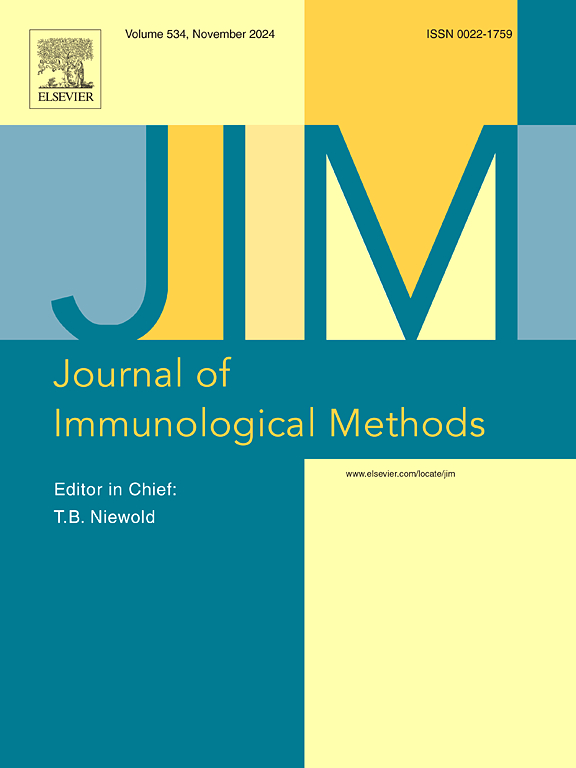从幼稚抗体噬菌体文库中分离抗肺泡瘤分泌蛋白 5 (ASP5) 抗体。
IF 1.6
4区 医学
Q4 BIOCHEMICAL RESEARCH METHODS
引用次数: 0
摘要
子囊梭菌是一种寄生线虫,会释放多种蛋白质来操纵宿主的免疫反应,以促进其生存。在这些释放的蛋白质中,疟原虫分泌蛋白5(ASP5)在介导宿主与寄生虫之间的相互作用中发挥着关键作用,因此成为干预由疟原虫引起的犬钩虫感染的一个很有前景的靶点。抗体噬菌体展示是一种广泛用于生成人类单克隆抗体的方法,本研究采用了这种方法。细菌表达系统用于生产 ASP5,以进行生物扫描。从原始人类抗体库(HAYLY)中生成了针对 ASP5 的单链片段可变(scFv)单克隆抗体。对产生的 scFv 抗体进行了表征,以阐明其抗原结合特性。鉴定出的单克隆抗体显示出良好的特异性和结合特性,突出了其在抗钩虫感染诊断应用中的潜力。本文章由计算机程序翻译,如有差异,请以英文原文为准。
Isolation of anti-Ancylostoma-secreted protein 5 (ASP5) antibody from a naïve antibody phage library
Ancylostoma species are parasitic nematodes that release a multitude of proteins to manipulate host immune responses to facilitate their survival. Among the released proteins, Ancylostoma-secreted protein 5 (ASP5) plays a pivotal role in mediating host-parasite interactions, making it a promising target for interventions against canine hookworm infections caused by Ancylostoma species. Antibody phage display, a widely used method for generating human monoclonal antibodies was employed in this study. A bacterial expression system was used to produce ASP5 for biopanning. A single-chain fragment variable (scFv) monoclonal antibody against ASP5 was generated from the naïve Human AntibodY LibrarY (HAYLY). The resulting scFv antibody was characterized to elucidate its antigen-binding properties. The identified monoclonal antibody showed good specificity and binding characteristics which highlights its potential for diagnostic applications for hookworm infections.
求助全文
通过发布文献求助,成功后即可免费获取论文全文。
去求助
来源期刊
CiteScore
4.10
自引率
0.00%
发文量
120
审稿时长
3 months
期刊介绍:
The Journal of Immunological Methods is devoted to covering techniques for: (1) Quantitating and detecting antibodies and/or antigens. (2) Purifying immunoglobulins, lymphokines and other molecules of the immune system. (3) Isolating antigens and other substances important in immunological processes. (4) Labelling antigens and antibodies. (5) Localizing antigens and/or antibodies in tissues and cells. (6) Detecting, and fractionating immunocompetent cells. (7) Assaying for cellular immunity. (8) Documenting cell-cell interactions. (9) Initiating immunity and unresponsiveness. (10) Transplanting tissues. (11) Studying items closely related to immunity such as complement, reticuloendothelial system and others. (12) Molecular techniques for studying immune cells and their receptors. (13) Imaging of the immune system. (14) Methods for production or their fragments in eukaryotic and prokaryotic cells.
In addition the journal will publish articles on novel methods for analysing the organization, structure and expression of genes for immunologically important molecules such as immunoglobulins, T cell receptors and accessory molecules involved in antigen recognition, processing and presentation. Submitted full length manuscripts should describe new methods of broad applicability to immunology and not simply the application of an established method to a particular substance - although papers describing such applications may be considered for publication as a short Technical Note. Review articles will also be published by the Journal of Immunological Methods. In general these manuscripts are by solicitation however anyone interested in submitting a review can contact the Reviews Editor and provide an outline of the proposed review.

 求助内容:
求助内容: 应助结果提醒方式:
应助结果提醒方式:


